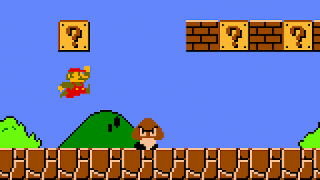Why Super Mario Bros. Was So Successful
Super Mario Bros. is the best selling video game franchise of
all time, with over 222 million units sold across all genres and
platforms. 222 million! Incredible! But you wouldn’t expect less from one of the
most beloved heroes of all time, a hero who at one time helped to single-handedly
save a struggling video game industry.
Behind those baggy overalls and red cap lie an incredible
game design experience, one that has withstood the test of time and established
a high bar for the level of fun and enjoyment required for a commercial video
game. What can modern day developers
learn by analyzing the Game Design Canvas of the original Super Mario
Bros.? A lot, as it turns out. The principles that made Super Mario Bros. a
hit back then still apply today.
In “Game Over”, an excellent account of the history of
Nintendo, Shigeru Miyamoto, creator of Mario, referred to his experiences as a
child. He discussed the feeling of
seeing something, such as a manhole on the wall, and wondering, “Why is there a
manhole on the wall? Where does it lead?” When he made Super Mario Bros., he sought to
recreate that same experience for his players.
As it turns out, this is a child-like experience that millions around
the world were longing to relive as well, and was one of the most massive
contributing factors to its wild success.
Breaking it down
Let’s try to figure out what the Core Experience of Super
Mario Bros. is. Defeating enemies? No, you can run through almost every level
without attacking the enemies at all.
Saving the princess? No, the
relationship between our intrepid plumber and the princess is almost entirely
left up to the player’s imagination; that aspect of the game seems tacked on.
I propose that the Core Experience of the original Super
Mario Bros. is to make the player feel like they are “Exploring and Conquering
a Strange World.” How did I come to this
conclusion? Let’s break it down in the
Game Design Canvas"
By looking at the supporting four aspects of the Canvas, we
can see that all of them point to a common theme.
The Base Mechanics set the standard for side-scrollers:
running and jumping over the terrain, navigating up, down, left, and right
through the stages. The Punishment and
Reward Systems encourage exploration as well.
The player is taught to avoid enemies, of course. That helps give the game its challenge. However if Mario dies, then he is reset to
the beginning of that world or level, not the beginning of the game as was
common with most high-score type video games of the 80′s. This reduces the punishment of failing
completely and beckons the player to try exploring the level until they run out
of time.
Other aspects of the game provide Reward for the player’s
penchant for exploration. Hidden coin
blocks may give the player coins or 1-up mushrooms, but they never appear
unless the player is willing to jump incessantly all over the map. Additionally, the player has no way of
knowing which pipes he or she can enter, and even if they did, the player has
no way of knowing where it will lead.
Numerous levels Reward the player’s investigation over walls, past
checkpoints, and under pipes. Warp zones
are tucked away past the apparent end of the level, allowing rapid advancement
to the game’s later stages. You’ll
notice that the game also doesn’t include a map, and there is no way for the
player to know what is coming up next.
All they can do is walk to the right until it shows up on their screen.
As for the game’s Long Term Incentive, I was tempted to say
that it is completing the game, but I think the Core Experience would beg to
differ. The player has no idea how many
levels or worlds there are (unless of course they’ve read a guide), and so they
are pulled forward and asked to just keep going…keep going!
Finally, the Aesthetic Layout provides a great environment
for the player to explore. From mushroom
tops to night scenes and water bridges, the player doesn’t know what kind of
level is beyond the next stage or the next pipe. And this certainly is a strange world; don’t
let the classic nature of this game let you forget how strange it is to
juxtapose turtles, mushrooms, pipes, and princesses.
The success of Super Mario Bros. can be attributed to the
solidarity and simplicity of its Core Experience. At this point in time almost every game was
about working in a finite playing space and getting a high score (a la Space
Invaders or Pac Man). However, Super
Mario Bros. provided a completely new Experience, pushing the player to enter
realms not yet seen in the game.



Comments
Post a Comment